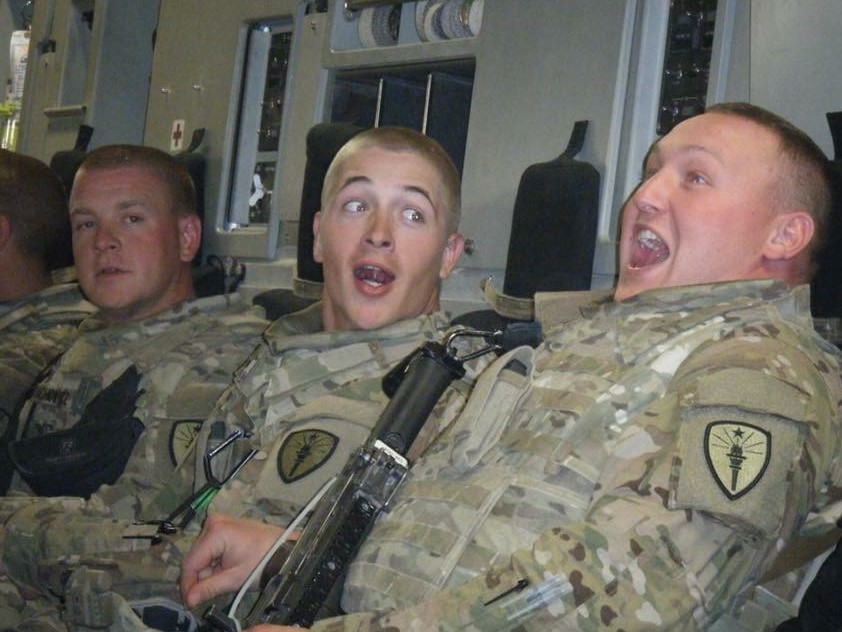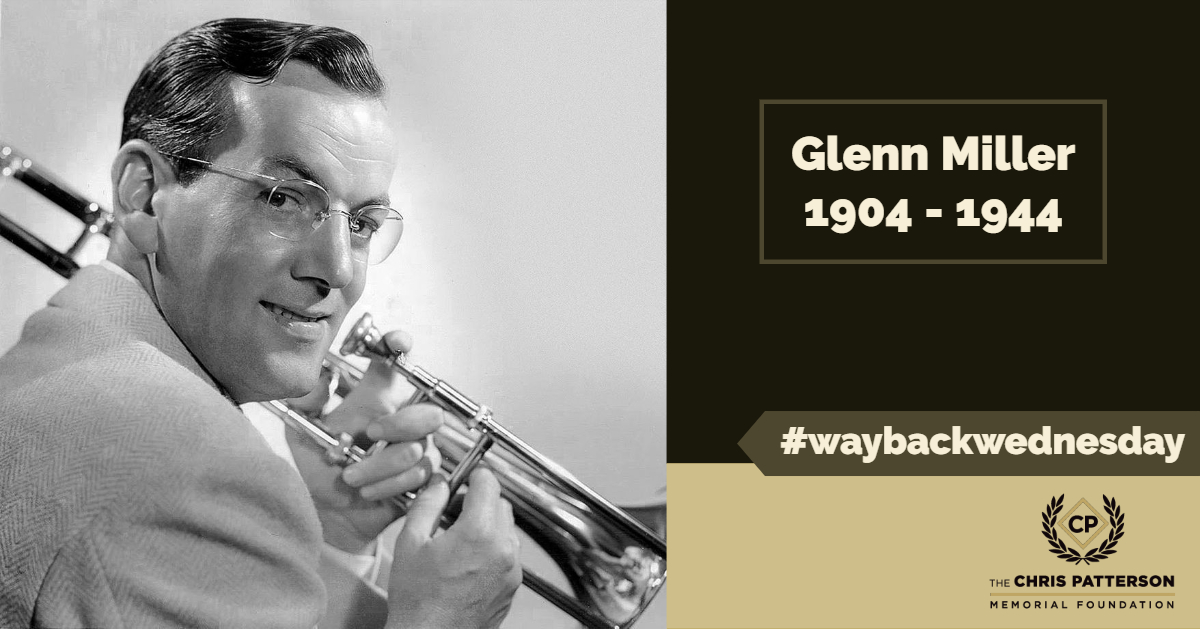Wayback Wednesday is a weekly series featuring historical figures with a record of military service and a connection to the arts.

This week features James Stewart actor and WWII Air Force commander.
James (Jimmy) Maitland Stewart was born May 20, 1908 in Indiana, Pennsylvania to Scottish Presbyterian parents. Stewart’s father did not approve of his sons early interests in the arts and the military, discouraging his sons pursuit of music lessons and insisting that he attend Princeton rather than the Naval Academy after graduating from high school. Away from his family, however, Stewart’s interests had the chance to flourish. At Princeton, he joined the University Players acting troupe and met and befriended former club member Henry Fonda. With Fonda’s support (the two would be roommates in New York City for several years while they launched their acting careers) Stewart began a career as an actor after graduating in 1932. At first the plays in which he appeared gained little traction, but by 1934 he was a rising star on Broadway. With the help of Fonda, who had signed a lucrative Hollywood contract, Stewart was scouted by MGM, took a screen test, and headed west to appear on the big screen in April 1935.
Between 1935 and 1942, Stewart appeared in an astounding 26 feature films. This included what would prove to be his only Academy Award for Best Actor, for his appearance in 1940’s The Philadelphia Story opposite Katharine Hepburn. Stewart’s splash in Hollywood was also a personal one, as he was universally described as kind, soft spoken, and a true professional in his craft. The likeable and mild mannered characters Stewart is often remembered for, such as George Bailey in the 1949 Frank Capra flick It’s a Wonderful Life, were not too far from the man himself. With conflict spreading across Europe, however, James Stewart was determined to be more like George’s military hero brother, Harry.
James Stewart’s family had deep military roots; the family tree contained veterans of the American Revolution, both of Stewart’s grandfather’s had fought in the Civil War, and Stewart’s father had fought in the Spanish-American War and WWI. Stewart’s quest to serve began before the US entered WWII, with his attempts to enlist stretching from October 1940 to May 1941. The military was not terribly keen on having a celebrity aboard, particularly as war time exigencies were not yet in effect. Stewart had an ace up his sleeve, however. In 1935 he was certified as a private pilot, and in 1938 received his certification as a commercial flyer. He frequently flew cross country, following the rail lines, to visit his family back east, and even participated in a 1939 cross-country flying race as a co-pilot. At a time when the US military was in desperate need of trained pilots, the knowledge of which was part of the reason he had volunteered, Stewart was highly proficient. Initially facing rejection due to failing to meet weight requirements (he did not mass enough) Stewart was able to work with MGM trainer Don Loomis to bulk up, and was finally inducted into the Air Corps on March 22nd, 1941. As he had beat the rush to enlist, Stewart was the ‘first celebrity in uniform’ following Pearl Harbor.
The US entry into WWII removed obstacles to Stewart’s progress in the military. At 33 he was 6 years too old for the Aviation Cadet training that was the usual path to becoming an air officer. Aiming to recruit and train 100,000 young men after the outbreak of war, however, the rust was cleared away from the bureaucracy of the United States Army Air Corps and experienced flyers like James Stewart were slotted into positions of authority to steer the new recruits that were soon pouring in. Stewart was commissioned as a second lieutenant on January 2nd, 1942. Stewart’s immediate fear was that his celebrity and experience would keep him stateside working as a trainer and recruiter. And his early experience in the war seemed to bear this out in full. During 1942 and the first part of 1943, in addition to assisting (and sometimes starring in) recruitment and propaganda films, Stewart struggled to get into the fight. After three months of training on the new B-17 Flying Fortress, he was transferred to a training unit in Boise, Idaho rather than to a combat unit.
By July 1943, Stewart had risen to the rank of Captain and been qualified as a squadron commander, and rumors had begun to circulate that he was to be taken off flight duty altogether and relegated to selling bonds and starring in promotional, training, and recruiting films. At 35 and despairing of ever getting anywhere near his country’s enemies, Stewart sought the help of his 30 year old commander, Lt. Col. Walter E. Arnold. Arnold, who, to his credit, sympathized with Stewart and helped clear the way for him with a recommendation to the newly formed 445th Bomb Group of the 703rd Bombardment group. He was assigned to the 445th in August 1943, and in three weeks’ time was made its commander. Flying B-24 Liberator’s, Stewart and his squadron flew to England, and after three (3) weeks of training (during which Stewart made a point of flying with each of the combat crews in his squadron) Stewart had his wish. He flew his first combat mission on December 13th, 1943.
During his time with 445th, he would fly 12 combat missions, often deep behind enemy lines. On March 30th, 1944 Stewart was reassigned to the 453rd Bombardment Group as chief operations officer, after the 453rd had lost his predecessor (and their commanding officer) on missions. Stewart was assigned to the 453rd ‘for the duration’ and was thus no longer required to fly a certain number of missions to complete his service. He continued to assign himself for flight duty, however, initially taking charge of the lead plane on several raids deep into Germany to inspire his new unit. While official records credit him with 20 total sorties with the 445th and 453rd, Stewart had a tendency that would come into full flower following his July 1st, 1944 promotion to Lieutenant Colonel; flying uncredited. Reassigned following his latest promotion as executive officer to Brigadier General Edward Timberlake of the 2nd Bomb Wing, Stewart took on a growing number of uncredited missions with both former and new squadrons. By the end of the war, he was a full colonel in charge of the 2nd Bomb Wing.
Following the war, Stewart returned home and continued his illustrious acting career. In total between 1935 and 1991, he appeared in no fewer than 92 films, television series, and shorts. He won just about all of the highest honors it was possible to win as an actor, and in 1999 was rated by the American Film Institute as the third greatest screen actor in film history. He also continued his service as part of the Army Air Force Reserve until retiring in 1963, rising to the rank of Brigadier General and keeping current his certification on the Convair B-36 Peacemaker, the B-47 Stratojet, and the B-52 Stratofortress during his stints on active duty. During WWII, he received the Distinguished Flying Cross twice, the French Croix de Guerre, and the Air Medal with three oak leaf clusters. While happy to help with promotional materials, Stewart always steadfastly shunned any publicizing of the missions he participated in.
The aforementioned It’s a Wonderful Life offers, in some ways, a picture of the dual nature of Stewart’s time during the second world war. His service was very much a combination both of George Bailey’s hard work rallying the home front and brother Harry’s airborne heroics. To have played both roles in real life is a fitting summary of James Stewart’s contributions to both the silver screen and the United States Air Force.
Wayback Wednesday is a weekly series featuring historical figures with a record of military service and a connection to the arts.

This week features Bernardo de Galvez and his men, the shadows of whom still live on in the corners of the Marine Hymn.
Adopted in 1929 as the official song of the United States Marine Corps (USMC), the Marine Hymn is the oldest official song of the US Armed Forces. It is usually sung by the Corps at attention as a gesture of respect, and most adults in the US can readily recognize the song and provide a few of the lyrics. The song begins:
From the Halls of Montezuma
To the shores of Tripoli;
We fight our country’s battles
In the air, on land, and sea;
First to fight for right and freedom
And to keep our honor clean;
We are proud to claim the title
Of United States Marine.
Like the whole of the song, a great deal of history of the USMC and the country they fight to protect is caught up in the very first line, ‘From the Halls of Montezuma.’ This opening line is a reference to the September 12-13, 1847 Battle of Chapultepec, during which 400 Marines on detached duty led the storming of an imposing bastion at what would prove to be the defining moment of the Mexican War. Chapultepec was a fitting place for the fight, given its connection to an iconoclastic Spanish Viceroy and a band of militia in the American Revolution.
In 1785, the construction of Chapultepec Castle was ordered by newly appointed Viceroy Bernardo de Galvez as a summer home for the Viceroyalty. Galvez had earned the posting through his actions as governor of Spanish Louisiana. The strategic port of New Orleans, a back door to the colonies, proved critical in the early years of the Revolution as a road for smugglers and haven for privateers.
As Governor-General, Galvez carried out with enthusiasm his government’s desire to covertly support the Americans. Working with an agent of the fledgling United States, Oliver Pollock, Galvez strove to ensure the efficient acquisition and transport of supplies up the Mississippi River, commissioning new trails to make the trip easier. As Spain was ostensibly neutral, New Orleans could not be blockaded and the British had too much already on their hands to protest too strongly Galvez’s protection of privateers and smugglers. Things became more complicated in 1779 when Spain, like France and the Netherlands, entered the war on the side of the Thirteen Colonies.
Days after Spain’s declaration of war on Great Britain, a letter was sent from King George III and Prime Minister Lord St. Germain to General John Campbell at Pensacola in British Florida, instructing him to begin organizing an attack on New Orleans. The letter fell into allied hands, and was brought to Galvez. The British campaign was to be dependent on gathering forces from across the Caribbean; Galvez quickly and quietly began organizing an expedition to attack first.
On August 21st, Galvez set out from New Orleans with a force of 520 regulars (2/3rds recent volunteers), 60 militiamen, 80 free blacks, and 10 American volunteers led by the intrepid Mr. Pollock. Journeying north to attack the British stronghold at Baton Rouge, local Creoles, Indians, Tejanos, and Hispanics swelled his numbers to 1,400. After a delaying action by the British at Fort Bute, Galvez pressed on to besiege the 400 British soldiers at Baton Rouge. After eight days, caught off guard and not expecting to be on the defensive, the British surrendered. Having secured the lower Mississippi against British interference, Galvez garrisoned his newly won territory and returned to New Orleans.
On January 20, 1780 Galvez set sail with a force of 1,300 men, which he soon had ashore below Fort Charlotte on the approaches to Mobile. The British force of 304 soldiers and militia put up a spirited defense, but was forced to surrender after the walls were breached by Spanish artillery.
In the fall of 1780, the British at Pensacola, now their last stronghold in the region, were given extra time to prepare their defenses when Galvez next assault expedition was dispersed by a hurricane. Galvez was not delayed long, regrouping and getting an army to Pensacola by March 1781. General Campbell had thought, following the hurricane, that he had an opportunity to seize the initiative and was caught with some of his forces away from Pensacola’s fortifications. Still, Campbell had pulled together a total of 1,300 regulars, Indians, and militia. While the Spanish started with only a small advantage in numbers, Galvez had arranged for the flood of reinforcements, supplies and laborers needed for a long siege. By May of 1781, the Spanish had overwhelming force available. Under ever heavier bombardment, with their outer fortifications having fallen to the Spanish force, the British garrison surrendered on May 8, 1781.
When the war ended in 1783, Galvez was in the process of planning the conquest of British Jamaica. His efforts and those of his men denied the British the possibility of a second front against the colonists, ensured supply lines to the Continental Army through the Gulf or Mexico, and effected the forces on both sides during the final battles of the war. Additional French and Spanish soldiers and ships were available for the Yorktown campaign, while the British had to contend with reinforcing their now vulnerable Caribbean possessions.
For his efforts, Galvez was recognized by the Continental Congress and by General George Washington himself. He is remembered through a smattering a street names in Louisiana and Florida, a statue in Washington DC erected in 1976 for the centennial, and in one large city that bears his name (Galvezton, TX). He was rewarded with the Viceroyalty of Cuba and then of all New Spain in 1783. In addition to commissioning Chapultepec Castle, Galvez sponsored a botanical expedition, patronized the arts, donated a portion of his annual salary to charity, and in general continued to be an energetic and effective leader.
Alas, Spain’s imperial decay began to catch up with him. In a weakening empire, the best and brightest were increasingly subject to official skepticism and sanction. Before the full weight of official displeasure could catch up with him, Galvez died at the age of 40 on November 30th, 1786. Suspicions of possible poisoning persist to this day, though a typhoid epidemic was likely the culprit. In 2014, he became one of only eight individuals in history awarded honorary United States citizenship. In his energy, curiosity, and lack of concern for those conventions that he deemed unhelpful, Galvez was perhaps better representative of the New World than the Old that he had pledged service to. As for the troops that fought with Galvez, they would wait close to 25 years before securing their portion of the freedom won in the war they had fought. With the 1804 conclusion of the Louisiana Purchase, they gained their American citizenship.
A bit messy and somewhat unlikely, like the United States itself, today for #waybackwednesday we honor Galvez and his men, the shadows of whom still live on in the corners of the Marine Hymn.

Update: A quick note following up on Wednesday’s posting, regarding the Marines who participated in the assault on Chapultepec. A total of 400 Marines were present with General Winfield Scott in 1847 as he attempted to take the capitol of Mexico City by circling to the west. Chapultepec Castle, on a rise of 200 feet, guarded that approach and would have to be taken. After having to persuade most of his officers that attacking the imposing height was advisable, Scott set the attack for September 13th. September 12th was spent in bombardment and positioning troops. Three enveloping forces totaling 2,000 soldiers, under Generals Gideon Pillow, William Worth, and John Quitman were to go forward. Preceding these troops were two storming parties of 250 men each, commanded by Major Levi Twigg and Captain Samuel MacKenzie. These two parties, which included 40 Marines with Twigg, were considered ‘forlorn hopes’ intended to come to blows with the enemy as quickly as possible and draw almost certainly fatal amounts of the defender’s attention.
They indeed took hideous casualties, but proceeded on ahead of the attack rather than falling back. Upon reaching the walls of Chapultepec, hideous hand to hand fighting ensued with neither side seeking or giving quarter. It was here, having reached the walls, where the Marines tenacity helped carry the day. At the forefront of the push into the castle itself, the famed ‘Halls of Montezuma.’ When General Scott entered the castle after the battle, he found the streets inside guarded by the surviving Marines. A remarkable testament, given their exhausting contribution to the fight, the chaos and disorganization that usually accompanies a hard fight for any strong point, and the fact that 90% of the Marine officers and noncommissioned officers who participated in the fight were casualties.
In addition to the reference in the Marines Hymn, the scarlet ‘blood stripes’ were added to Marine dress uniforms in memory of the fallen at Chapultepec. The Marines had been around since their formation by an act of the Second Continental Congress on November 10th, 1775 (thus preceding the Declaration of Independence). As odd as it may sound today, the USMC lacked in its early history the esprit de corps and hard-hitting aura that it possesses today. It was not long before the American Revolution, after all, that Samuel Johnson expressed the opinion of many in the English speaking world about service aboard a ship when he wrote, “No man will be a sailor who has contrivance enough to get himself into a jail; for being in a ship is being in a jail, with the chance of being drowned… a man in a jail has more room, better food, and commonly better company.” The reputation of the United States Marine Corps was earned, not given, in hard fighting and blood. Some done in battles remembered still in song, such as Chapultepec, and others in fighting that is today largely forgotten.
Wayback Wednesday is a weekly series featuring historical figures with a record of military service and a connection to the arts.

This week features Chicagoan and member of the WWII Monuments, Fine Arts, and Archives (MFAA) program, Richard Barancik.
An army is a complicated thing, with many different roles to play and not all impacts on civilian life easily foreseen. In 1943, with WWII in full swing, a group of men and women with unique training were given a special task. Their unique skills were in the arts and preservation, and their task was to safeguard (and sometimes find, if they had been relocated during the German occupation) cultural monuments across Europe.
War in the 20th century was, to put it mildly, hugely messy. And Europe, particularly without its current modern infrastructure, was a fairly big place with lots of art and monuments for the 400 individuals of the Monuments, Fine Arts, and Archives (also known as the ‘Monuments Men’) program to track down and protect. It was not perhaps the most heroic posting in the army, but the members of the MFAA were dedicated to what they did. They provided intelligence to army and air force officers that allowed them to, as possible, minimize damage to museums, monuments, and structures of historic significance. Far from using the their posting to hang back, MFAA personnel often arrived in liberated communities just after the Germans had left and before allied troops entered. Captain Walter J. Huchthausen, who was killed by gunfire while trying to salvage an altarpiece, and Major Ronald Balfour, killed by a shellburst while scouting for hidden artworks beyond allied lines, are symbolic of their dedication.
At the age of 18, Chicagoan Richard Barancik joined the Army Enlisted Reserve Corps in December of 1942. In 1943 he attended the Army Specialized Training Program (ASTP) and attended basic engineering courses at the University of Nebraska. In 1944, he was sent to Europe with the 66th Army Division. Originally headed for the Battle of the Bulge, the 66th was instead sent to besiege the German fortifications at St. Nazaire after 700 soldiers were lost when their transport ship, the SS. Leopoldville, was torpedoed. Barancik then headed to Southern France before being reassigned to Austria, where he came across the MFAA cataloging, archiving, and repairing caches of art hidden by the Nazi leadership. He immediately volunteered for service with the MFAA and was accepted. Barancik recalled later that, “When I arrived in Salzburg, I was not only overwhelmed by the beauty of the town but the quality of the men in the Fine Arts Section. They were typically older and very well educated in the Fine Arts.” Following the war, Barancik would manage to pile up achievements worthy of the company he had been keeping. Barancik studied architecture at the University of Cambridge in 1946 and at the Ecole des Beaux-Arts at Fontainebleau, France in 1947. He received his Bachelor of Science in Architecture and Bachelor of Science in General Studies at the University of Illinois in 1948. From 1950 to 1993, he enjoyed a long and prosperous career as a prominent Chicago architect.
Other, similarly motivated and talented members of the MFAA went on to help found the National Gallery of Art, the Metropolitan Museum of Art, and the New York Ballet along with a slew of smaller museums and institutions across Europe and the United States. An outcome from the chaos of WWII no less welcome for being so unexpected. War is, after all, as much (if not more) what is protected as who you fight. And Barancik and the other members of the Monuments, Fine Arts, and Archives program exemplify this in their unusual service during WWII. They probably deserved a better movie than the 2014 Monuments Men. I recommend the book Monuments Men: Allied Heroes, Nazi Thieves and the Greatest Treasure Hunt in History by Robert Edsel, which is much better, if you would like to learn more.
“There are three deaths. The first is when the body ceases to function. The second is when the body is consigned to the grave.
The third is that moment, sometime in the future, when your name is spoken for the last time. “
-David M. Eagleman, Sum: Forty Tales from the Afterlives

Sergeant Brian J. Leonhardt
Merrillville, IN
Operation Enduring Freedom – January 6th, 2012
“Brian Leonhardt will always be remembered as a soldier who gave of himself unconditionally for others and his country. No surprise, as he began that trend in high school: giving himself for others, his school, and his team.” –Coach Phil Santaguida
As a high school basketball player, Brian set the school record for taking charges. In pursuit of that record, Brian had to set both feet and defend his basket in the face of an oncoming offensive player. He worked hard to perfect the stance and got knocked to the floor countless times. He received many scrapes, bruises, and even a permanent “fat lip” while helping his team to an undefeated season that year and on to a championship. He loved his team, and he gave himself for them.

As a brother to seven siblings, he was the family goofball. He established himself early as the family storyteller with his big, baby blue eyes, hilarious facial expressions, and his flair for relaying a great tale. As he got older, his quick wit and even quicker tongue was always ready for a laugh, usually at the expense of his siblings. “We always knew that if we needed a hand, we could call Brian. Whether it was a call in the pouring rain for help changing a tire on the side of the road or an early-Saturday-morning call from a sister who needed him to cart home a “bargain” recliner in his truck for her after he’d worked late the night before, he would be there to help. He was a devoted uncle to his nieces and nephews. He spoiled them with gifts and attention—always affectionate and patient.” said his sister, Theresa Leonhardt Stoneback

His younger sister, Jackie Leonhardt said, “Brian was an amazing big brother! He was funny, smart, caring, and extremely over protective! He always made time for the people he loved… I remember one night when I was 18, I came home from work and he asked me to go outside with him…he opened the tailgate on his truck, and we just sat there…looking up at the sky…he showed me all the constellations he could see. He taught me how to shoot a basketball, he would spend hours with us shooting hoops, the many rides in the truck…whatever we were doing, he was making us laugh. He was an amazing person. And he is still missed dearly.”
Brian loved Nutella, the Heat basketball team, Oakleys, guns, and his collection of gym shoes. But he really loved his sweetheart, Dianne. He proposed in July of 2011. On a September day a couple of months later, they quietly married, telling only a few people. They were planning a big ceremony when he returned after his deployment. He loved his family, and he gave of himself for them.
Before Brian even graduated high school, he knew he wanted to be in the Army National Guard. Three of his older brothers were serving or had served in the National Guard, and he was so proud to be a combat engineer. He loved being a soldier. One of the last posts on his social media was: “A hero is someone who has given his/her life to something bigger than oneself.” He is truly our hero.
“Greater love hath no man than this, that a man lay down his life for his friends.” –John 15:13
Fallen Friday is a weekly series which highlights the story of a fallen service member,
so that their name and story continues to live on.
Wayback Wednesday is a weekly series featuring historical figures with a record of military service and a connection to the arts.

This week features big-band leader, Glenn Miller.
When Glenn Miller broke through onto the music scene in 1938, he was already 34 years old and had spent years on the big band circuit without achieving the success he craved. Finally having landed on a unique sound and assembled the right band members to deliver on his arrangements, his Glenn Miller Orchestra landed a new contract with Bluebird Recording and was able to book a series of prominent live shows. To say they became famous is an understatement; between 1939 and 1942, Miller would log 17 number one records and 59 top ten hits. For those keeping score at home, the Beatles had 33 top ten hits, and Elvis Presley had 38. In 1942, however, Miller was determined to set aside his hard won fame and contribute to the war effort. At the peak of his fame and earning between $15,000 to $20,000 per week, which would still be pretty fantastic in 2019, Miller first had to find a way to get into a then-hard-pressed military wary of more bad press.
At 38, Miller was too old to be drafted and so sought to volunteer his services. He first offered his services to the Navy, who turned him down. Changing tack, he wrote to Army Brigadier General Charles Young and asked to “be placed in charge of a modernized army band.” On October 8, 1942 he reported for duty in Omaha, NE for service with the Seventh Service Command in the Army Specialist Corps. Miller quickly set to work revolutionizing the army band, with his fame and the war effort paving the way past unhappy traditionalists. Based in New Haven, CT and then New York City, Miller and his band performed a weekly radio broadcast entitled I Sustain the Wings. In 1944 he won permission to form his 50 piece Army Air Force band and take it to England, where they gave over 800 performances. While there, Miller and his band recorded a series of their songs in German for use on propaganda broadcasts.
On December 15th, 1944 Miller boarded a small plane headed for Paris, scouting ahead as he planned for the City of Lights to be the next stop for his AAF band. Despite his distance from the front, Miller had had his close calls already. After a bomb landed within three blocks of his offices in London he was persuaded to relocate, as it does not do to have the enemy blow up your morale effort. The day after leaving, a V-1 flying bomb struck the building, killing 70. Now, with bad weather closing in, Miller’s flight disappeared over the channel. Wreckage was never found, leading to years of conspiracy theories. The UC-64 Norseman he had been flying aboard had a carburetor that was notorious for icing up in cold weather. He was 40 years old, and left behind a wife and two adopted children. They accepted the posthumously awarded Bronze Star on his behalf.
Miller’s musical work continued to have an impact down through the years, often inspiring (and being imitated by) other artists. Former band members formed a ghost band, dedicated to performing Miller’s work. After a few fits and starts, with disagreements between former band members, in 1956 an official ghost band ‘stuck.’ The band is still touring the United States today, a testament to Miller’s lasting popularity and enduring musical contributions. While Miller’s AAF Band was disbanded in 1945, its influence can be felt throughout the armed forces to this day. After WWII, most branches added a jazz band to their concert and marching bands. Music remains an important part of the American military tradition to this day. Miller would have had it no other way, stating in one of the propaganda recordings that, “America means freedom and there’s no expression of freedom quite so sincere as music.”